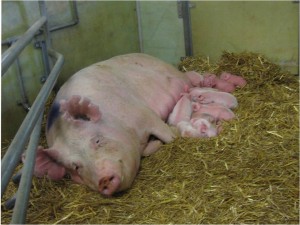This post is the abstract of a student report:
Edman, F. 2014. Do the Member States of the European Union comply with the legal requirements for pigs regarding manipulable material and tail docking? Student report 572, SLU, Skara, Sweden. Accessed 17-2-2015.
Abstract
Tail biting behaviour is a major animal welfare issue in intense pig production, as well as an economic issue. To prevent the behaviour, tail docking is practised. It is a painful procedure where a part of or the whole tail is cut off.
There is a lot of research on the subject of tail biting, with a big variety of solutions to prevent the behaviour. Scientists are consistent about that the absence of manipulable material increases the risk for tail biting. Manipulable material works as an environmental enrichment and stimulates natural behaviours of the pig, such as investigation and rooting. It helps pigs to cope with the environment and reduces stress and frustration, triggers that can lead to tail biting.
The legal requirement regarding tail docking state that it shall not be practised on a routine basis and has been in force since the 1st of January 1994. It was strengthened in 2003 and now appears in Council Directive 2008/120/EC which codifies the earlier directives. The legal requirement now states that measures to prevent tail biting shall be taken before practising tail docking, measures such as changing inadequate management systems, changed environment and reduced stock densities.
Pigs shall also have access to a suitable material or object, to be able to perform natural behaviours and prevent tail biting and stereotypies. In the latest version of the directive on pigs this material was defined as straw, hay, wood, sawdust, mushroom compost, peat or a mixture of such.
The aim of this study was to investigate the current situation of compliance with the legal requirements in the directive on pigs, regarding the provision of manipulable material and the routine practice of tail docking. It was also to investigate actions to increase compliance among the Member States in the European Union. A descriptive analysis of available FVO-reports was used, together with written answers from the Competent Authorities and a qualitative interview with people at the Commission and the FVO.
The results of this report showed that 18 out of 28 Member States in the European Union do not comply with the legal requirement regarding the provision of manipulable material, and that 17 of the Member States do not comply with the legal requirement regarding the practice of tail docking. There has not been any actions such as sanctions to increase the compliance among the Member States.
These findings make an overall conclusion possible about the current issues with the compliance of the directive on pigs. There are no further intrinsic actions to increase compliance, due to a lack of responsibility among the involved parties, such as pig farmers, Competent Authorities and the Commision. Due to the lack of intrinsic action, it is an impossibility to conclude when full compliance will be fulfilled.






